- Step 1: The Groundwork
- Step 2: The Three Sections
- Step 3: Practice Makes Improvement
- The Secret Ingredient
- Understanding Basics Of Number Series
- Types Of Number Series Reasoning Questions
- Addition & Multiplication In Number Series
- Square & Cube-Based Number Series Patterns
- Missing Terms & Arranging Sequences
- Tricks & Tips For Solving Number Series
- Selected Number Series Questions With Solutions
- Frequently Asked Questions (FAQs)
- Must Know Terminologies in Blood Relation Questions
- Basic Approaches to Solve Blood Relation Questions
- Types Of Blood Relation Questions
- Tips For Solving Blood Relation Questions
- Multiple Choice Questions (MCQs) with Detailed Explanation
- Conclusion
- Frequently Asked Questions (FAQs)
- Letter Series In Logical Reasoning
- Types Of Letter Series Patterns
- Tips For Solving Letter Series Reasoning
- Best Practice Question Samples With Answers
- Conclusion
- Frequently Asked Questions (FAQs)
- Basics of Problems On Age-Related Questions
- Formula to Solve Problems on Ages-Related Questions
- Types of Age-Related Questions & Examples
- Tips & Tricks for Solving Ages Problems
- Best MCQs on Problems on ages with solved answers
- Conclusion
- Frequently Asked Questions (FAQs)
- Definition of Calendar
- Understanding Days of the Week
- What is a Leap Year?
- Concept of Odd Days in a Century
- Tips For Solving Calendar Reasoning Questions
- Best Calendar Reasoning Questions with Answers (MCQs)
- Frequently Asked Questions (FAQs)
- Basic Concepts of Clock
- Structure of a Clock
- Angle Equilavalence in Clock
- Tips For Solving Clock Questions
- Selected Clock Questions & Answers (MCQs)
- Conclusion
- Frequently Asked Questions (FAQs)
- Understanding The Concept Of Direction Sense
- Tips For Effective Problem-Solving In Direction Sense
- Practical Test Practice Questions And Answers
- Conclusion
- Frequently Asked Questions (FAQs)
- Importance Of Dice Reasoning
- Dice Numbers In Dice Reasoning
- Classification Of Dice
- Constructed Vs Deconstructed Dice
- Tricks & Tips For Solving Dice Problems
- Practice MCQs With Detailed Answers
- Conclusion
- Frequently Asked Questions (FAQs)
- Alphanumeric Series Defined
- Alphanumeric Series In Reasoning Tests
- Tips & Strategies For Solving Alphanumeric Series
- Practice Sample Questions With Detailed Answers
- Conclusion
- Frequently Asked Questions (FAQs)
- Concept Of Mirror Image Reasoning Explained
- Important Terms In Mirror Image Reasoning
- Types Of Mirror Images
- Identifying Correct Mirror Image
- Finding Clock's Mirror Image
- Tips To Solve Mirror Images
- Selected Practice Questions With Answers
- Conclusion
- Frequently Asked Questions (FAQs)
- Concept & Overview Of Input-Output
- Input-Output In Competitive Exams
- Types Of Input-Output Problems
- Strategies, Tips & Tricks For Solving Reasoning Questions
- Selected Practice Questions With Answers
- Conclusion
- Frequently Asked Questions (FAQs)
- Importance Of Finding The Odd One Out
- Tricks And Tips
- How to Find The Odd One Out?
- Solved MCQs with Detailed Explanation
- Conclusion
- Frequently Asked Questions (FAQs)
- Understanding Key Concepts
- Exploring Different Ranking Types
- Formula And Application Of Order And Ranking
- Tips For Solving Order & Ranking
- Selected Practice Questions And Answers
- Conclusion
- Frequently Asked Questions (FAQs)
- Importance Of Pipes & Cistern Aptitude
- Key Terminologies used in Pipes and Cisterns
- Pipes and Cisterns Formula with Examples
- Pipes and Cisterns Shortcut Tricks
- Tips For Solving Pipes & Cistern Problems
- Selected Questions & Answers For Practice (MCQs)
- Conclusion
- Frequently Asked Questions (FAQs)
- Key Concept in Boats and Streams
- Formulas Of Boats & Streams
- Distance & Time Formula
- Tips For Solving Boats & Streams Questions
- Selected Practice Questions With Answers (MCQs)
- Conclusion
- Frequently Asked Questions (FAQs)
- Concept of Mixture and Alligation
- Types Of Alligation Questions
- Formula for Solving Mixture & Alligation
- Tips For Solving Mixture And Alligation
- Selected Questions With Answers For Practice
- Conclusion
- Frequently Asked Questions (FAQs)
- Concepts and Definitions Related to Time and Work
- Important Time And Work Formulas
- Tricks and Tips to Solve Time & Work Questions
- Time And Work MCQs with Detailed Solution
- Conclusion
- Frequently Asked Questions (FAQs)
- What is Harmonic Progression(HP)?
- Formula to find the nth Term in Harmonic Progression
- Formula to find the Sum of the nth Term in HP
- What is Harmonic Mean?
- Harmonic Progression Solved Best MCQs
- Conclusion
- Frequently Asked Questions (FAQs)
- What is Mensuration in Maths?
- What are 2D figures in Mensuration?
- What are 3D figures in Mensuartion?
- Basic Terminologies In Mensuration
- Basic 2D Formulas in Mensuration
- Basic 3D Formulas in Mensuration
- 2D vs 3D in Mensuration
- Solved Questions With Solutions (MCQs)
- Conclusion
- Frequently Asked Questions (FAQs)
- Relationship Between Time, Speed And Distance
- Conversion Units Time, Speed And Distance
- Average & Relative Speed: Two Trains Moving in the same or opposite direction
- Solved MCQs on Time, Speed And Distance
- Conclusion
- Frequently Asked Questions (FAQs)
- What is Simplification in Maths?
- BODMAS Rule in Simplification Explained
- Simplification & Approximation Relation
- Key Terms in Simplification
- Examples Of Simplification Techniques
- Simplification Questions With Solved Answers (MCQs)
- Conclusion
- Frequently Asked Questions (FAQs)
- Height And Distance Important Terms
- Right Angled Triangle In Trigonometry
- Trigonometric Ratios
- Solved Examples For Better Understanding
- Height And Distance Applications In Trigonometry
- Height And Distance Practice Questions & Answers
- Conclusion
- Frequently Asked Questions (FAQs)
- Defining Interest Types
- Simple Interest Vs. Compound Interest
- Selected Solved Questions & Answers
- Conclusion
- Frequently Asked Questions (FAQs)
- Basic Concepts Of Profit And Loss
- Determining Selling Price
- Calculating Discounts
- Formulas For Calculating Profit And Loss
- Examples Of Profit And Loss
- Profit & Loss Questions With Detailed Solution
- Conclusion
- Frequently Asked Questions (FAQs)
- Defining Angle Of Elevation
- Key Terms Used In Angle Of Elevation
- Angle of Elevation Formula with Example
- Angle of Elevation vs. Angle of Depression
- Angle of Elevation MCQs with Answers
- Conclusion
- Frequently Asked Questions (FAQs)
- Defining HCF And LCM
- Calculation Methods Of HCF And LCM
- HCF By Prime Factorization Method
- LCM By Prime Factorization Method
- Difference Between HCF And LCM
- HCF & LCM Practice Questions With Answers
- Conclusion
- Frequently Asked Questions (FAQs)
- What is fraction and decimal?
- Understanding Decimal Fraction
- Place Value in Decimal Fraction
- Mathematical Operations with Decimal Fraction
- Practice with Solved Examples
- Summary
- Frequently Asked Questions
- All About Decimals
- All About Fractions
- How to Convert a Decimal into Fraction
- Simple vs Recurring Decimals
- Converting Recurring Decimals to Fractions
- Conversion Charts
- Practice Questions (With Solutions)
- Closing Thoughts
- Frequently Asked Questions
- What is Arithmetic Mean?
- Arithmetic Mean Formula- Ungroup Data & Group Data
- Merits of Arithmetic Mean
- Demerits of Arithmetic Mean
- Alternatives to Arithmetic Mean
- What is the Weighted Arithmetic Mean?
- Arithmetic vs. Geometric Mean
- Arithmetic Mean Application in Statistical Analysis
- Arithmetic Mean Practice Questions with Explanation
- Frequently Asked Questions
- What is Geometric Progression?
- Key Properties of Geometric Progression
- General Form Of Geometric Progression
- General Term or the Nth Term of Geometric Progression
- The sum of nth Terms of GP
- Types Of Geometric Progression
- Solved Questions and Answers of GP
- Conclusion
- Frequently Asked Questions (FAQs)
- Average in Maths
- Average Formula in Maths
- Differentiating Types of Average
- How to Calculate Average of Negative Numbers?
- Practical Applications of Averages
- Average Questions For Practice
- Frequently Asked Questions
- What is Simple Interest in Maths?
- Simple Interest Formula Explained
- Simple Interest Formula for Years, Months & Days
- Simple Interest Examples & Practice Questions
- Conclusion
- Frequently Asked Questions (FAQs)
- Defining Mathematical Ratios
- Understanding Proportions Fundamentals
- Differentiating Ratios from Proportions
- Ratio and Proportion Formulas
- Properties of Ratio and Proportion
- How to Solve Ratio and Proportion Problems
- Ratio and Proportion Problems (With Solutions)
- Summary
- Frequently Asked Questions
- What is Number in Maths?
- Types of Numbers With Example
- Real vs Complex Numbers Explored
- Basic Operations on Numbers
- Practice Questions (With Solutions)
- Frequently Asked Questions
- What is Arithmetic Progression (AP) in Maths?
- Important Terminologies in Arithmetic Progression
- Basic Terms in Arithmetic Progression
- General Form Of Arithmetic Progression Series
- Types Of Arithmetic Progression
- Solved Questions With Explanation (MCQs)
- Conclusion
- Frequently Asked Questions (FAQs)
- Understanding Basic Concept
- Importance Of Train Problems In Aptitude
- Tips To Solve Train Problems
- Selected Practice Questions & Answers
- Conclusion
- Frequently Asked Questions (FAQs)
- Definition Of Mode
- Calculating Mode For Ungrouped Data
- Calculating Mode For Grouped Data
- Bimodal, Trimodal & Multimodal Distributions
- Comparing Mean, Median & Mode
- Selected Practice Questions With Answers
- Conclusion
- Frequently Asked Questions (FAQs)
- Important Concept In Races And Games
- Calculating Time, Speed & Distance
- Importance Of Races And Games Problems
- Sample Practice Questions With Answers
- Conclusion
- Frequently Asked Questions (FAQs)
- Types Of Partnership
- Formula For Partnership Questions
- Tips To Solve Partnership Aptitude Questions
- Selected Partnership Questions (Practice MCQs)
- Conclusion
- Frequently Asked Questions (FAQs)
Mirror Image Reasoning | Concepts And Tips With Question & Answer
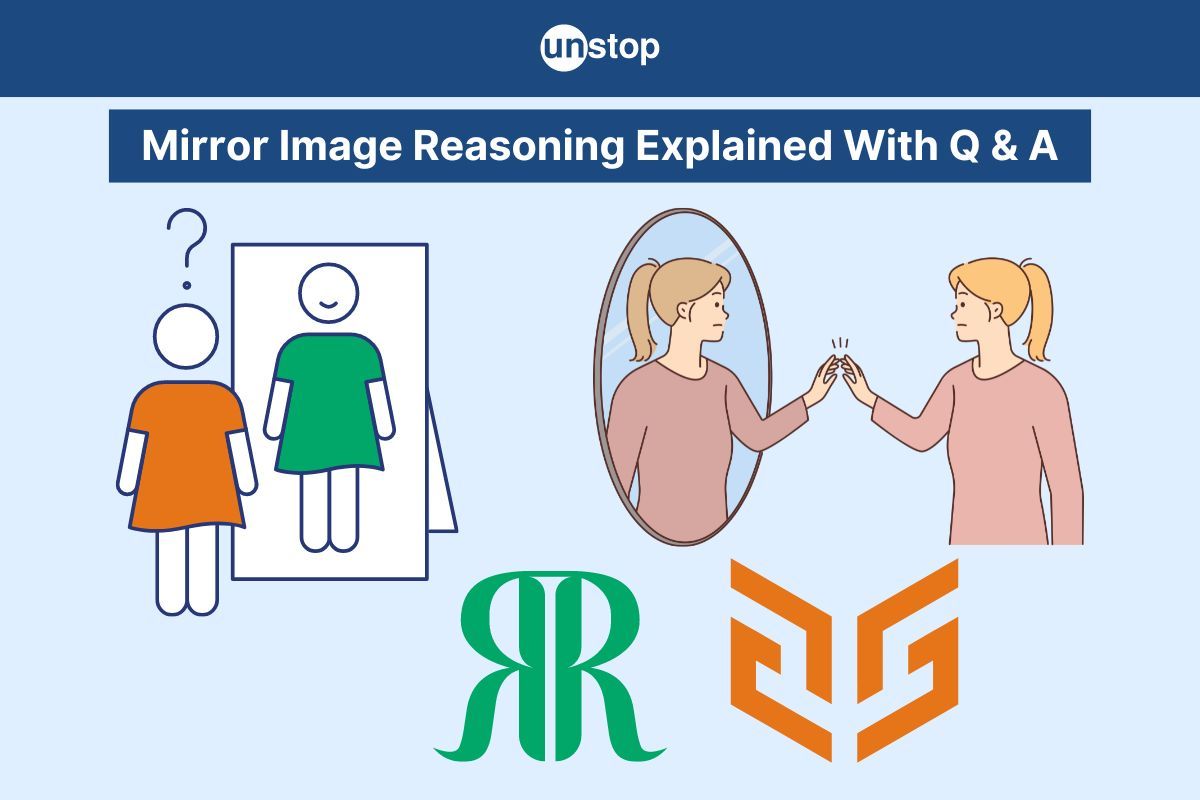
Ever wondered how students excel in exams and job placements? What if you could effortlessly enhance your critical thinking skills to tackle challenging questions? Mirror image reasoning offers a powerful tool for sharpening your cognitive abilities, improving problem-solving techniques, and boosting mental acuity.
Concept Of Mirror Image Reasoning Explained
Mirror images are essentially reflections seen in a mirror, where the left and right sides of an object appear reversed. This concept is fundamental in understanding symmetrical figures and patterns.

Important Terms In Mirror Image Reasoning
Let us study some of the important terms in mirror image reasoning:
Lateral Inversion
Mirror image reasoning involves lateral inversion, which is when the right side of an object is reflected as the left side and vice versa. This process is crucial in creating mirror images.
Sideways Reversal
Mirror images result in the reversal of sideways positions, where objects appear flipped horizontally. This effect occurs because of how light bounces off surfaces and reflects back into our eyes.
Orientation Of Mirror
The orientation of mirror images is significantly influenced by lateral inversion. For instance, if you raise your right hand in front of a mirror, it appears as if the reflected image is raising its left hand instead.
Types Of Mirror Images
Let us study the types of mirror images in mirror image reasoning:
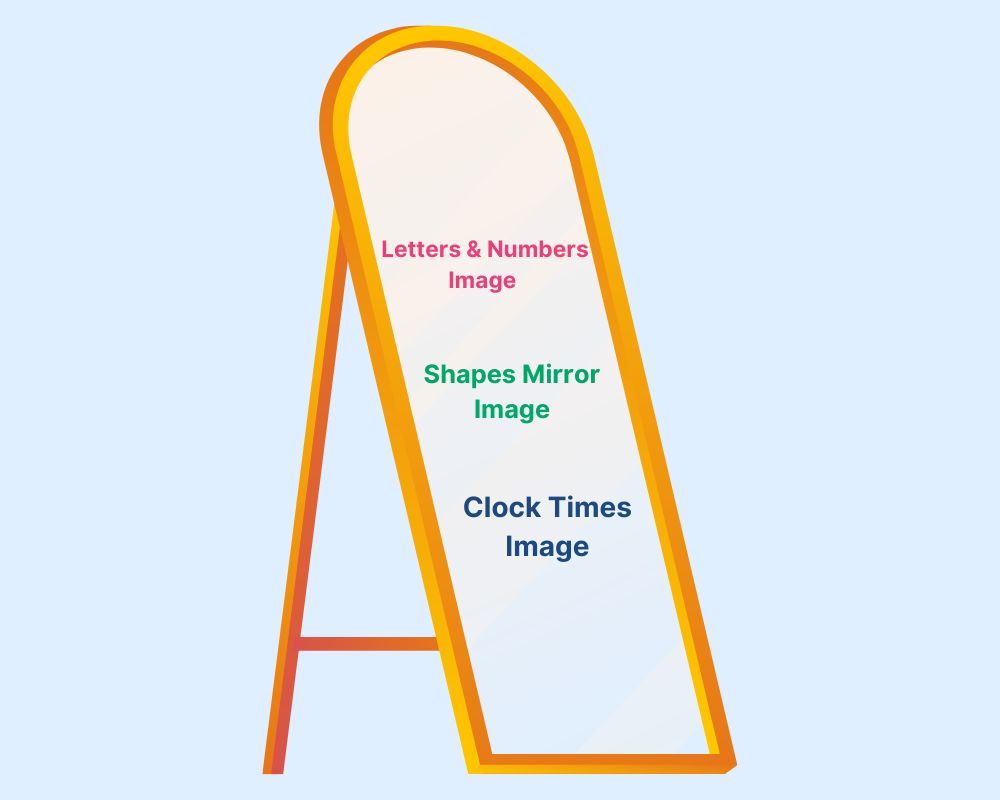
Letters And Numbers
Mirror images play a crucial role in various aspects, including letters, numbers, shapes, and even clock times. When it comes to letters, some have identical mirror images, retaining their original form when mirrored.
Shapes
In terms of shapes, the concept of mirror images can be more complex. Geometric shapes like squares, circles, and triangles may have distinct mirror images based on their orientation and symmetry.
Clock Times
Clock times also follow specific rules regarding mirror images. To reflect a clock time, the position of the hour and minute hands is reversed. For example, if the time is 6:30, its mirror image would show 5:30. This rule applies consistently across all clock times.
Identifying Correct Mirror Image
To identify the correct mirror image, focus on understanding how an object reflects across a line (line xy). Imagine flipping the object over this line to determine its mirror image. Pay attention to details, especially when dealing with asymmetrical objects.
Step-By-Step Guidance
Analyze: Examine the given object's features and orientation carefully.
Identify Line of Reflection: Determine the axis across which the object will reflect.
Mirror Image Placement: Picture where each part of the object would appear in its reflection.
Verify: Double-check by mentally flipping the object to confirm your choice.
Finding Clock's Mirror Image
To find the mirror image of a clock time, reverse the digits and then swap the positions of the hours and minutes.
Shortcuts
A quick way to determine mirror images is by focusing on specific patterns:
For Hours: Subtract the hour digit from 11 to get the mirrored hour.
For Minutes: Subtract the minute digit from 60 to get the mirrored minute.
Tips To Solve Mirror Images
Let us study some of the tips to solve mirror images:

Mirror Placement
Determining the correct position of the mirror is crucial in mirror image reasoning. Always remember that the mirror is perpendicular to the line of sight. This means that if an object is placed at a certain distance in front of the mirror, its image will be formed at the same distance behind the mirror.
Impact On Appearance
The placement of the mirror significantly affects how mirror images appear. When an object is placed closer to the mirror, its image appears larger and vice versa. Understanding this relationship helps in accurately visualizing and interpreting mirror images in logical reasoning.
Applying Lateral Inversion Rules
Mirror image problems can be effectively solved by applying lateral inversion rules. Remember that left becomes right and right becomes left in a mirror image. By consistently following this rule, you can correctly identify the orientation of objects in mirror reflections.
Selected Practice Questions With Answers
Provided below are some of the selected sample practice questions with detailed answers related to mirror image reasoning:
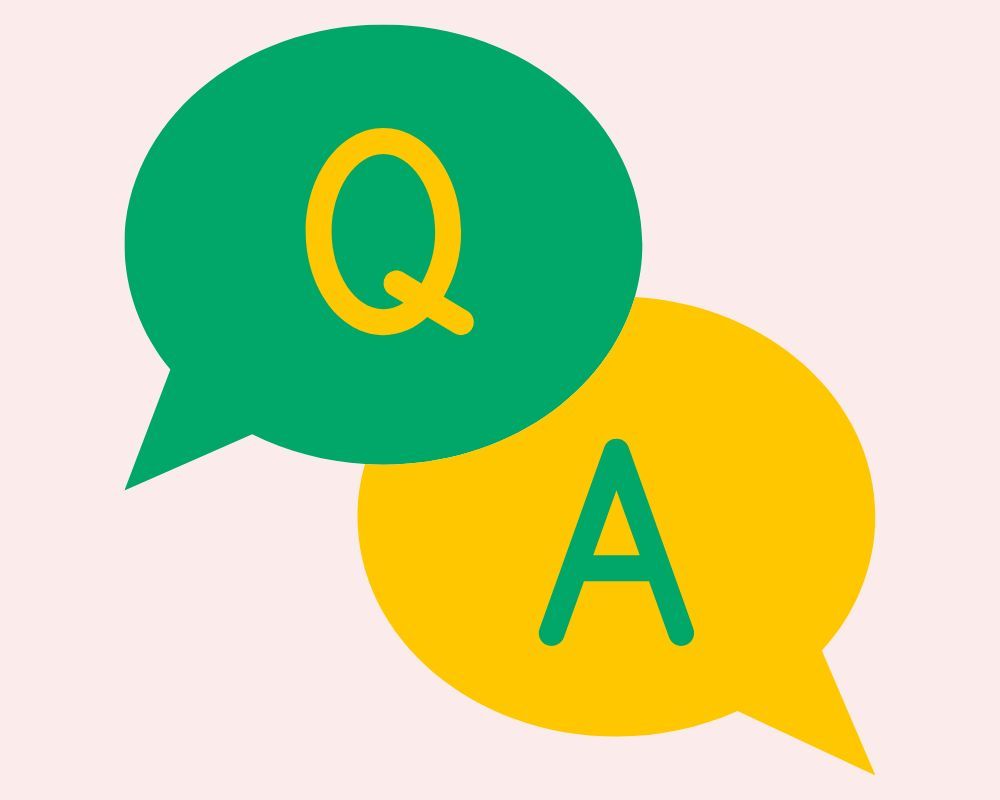
Question 1: What is the mirror image of the number ‘6’?
a) 6
b) 8
c) 9
d) 7
Answer: c) 9
Explanation: The image of ‘6’ will appear inverted in the mirror as ‘9’.
Question 2: What is the mirror image of the word ‘WON’?
a) NOM
b) WON
c) MOW
d) NOW
Answer: d) NOW
Explanation: The image of ‘WON’ will appear reversed and inverted as ‘NOM’.
Question 3: What is the mirror image of the word ‘MAD’?
a) DAM
b) ADM
c) MDA
d) WAD
Answer: a) DAM
Explanation: In the mirror, the image of ‘MAD’ will appear reversed and inverted as ‘WAD’.
Question 4: What is the mirror image of the letter ‘R’?
a) R
b) P
c) Я
d) Q
Answer: c) Я
Explanation: The mirror image of ‘R’ will appear as ‘Я’.
Question 5: What is the mirror image of the word ‘DOG’?
a) GOD
b) DOG
c) GDO
d) OGD
Answer: a) GOD
Explanation: The mirror image of ‘DOG’ will appear reversed as ‘GOD’.
Question 6: What is the mirror image of the word ‘TIP’?
a) PTT
b) IPT
c) TIP
d) PIT
Answer: d) PIT
Explanation: The mirror image of ‘TIP’ will appear reversed as ‘PIT’.
Question 7: What is the mirror image of the word ‘HAT’?
a) TAH
b) HAT
c) AHT
d) THA
Answer: a) TAH
Explanation: The mirror image of ‘HAT’ will appear reversed as ‘TAH’.
Question 8: What is the mirror image of the word ‘LOW’?
a) OWL
b) LWO
c) LOW
d) WOL
Answer: d) WOL
Explanation: The mirror image of ‘LOW’ will appear reversed as ‘WOL’.
Question 9: What is the mirror image of the word ‘DIP’?
a) IDP
b) PDI
c) DIP
d) PID
Answer: d) PID
Explanation: The mirror image of ‘DIP’ will appear reversed as ‘PID’.
Question 10: What is the mirror image of the word ‘CUP’?
a) PUC
b) CUP
c) UCP
d) PUD
Answer: a) PUC
Explanation: The mirror image of ‘CUP’ will appear reversed as ‘PUC’.
Conclusion
Understanding mirror images is crucial for acing various exams and sharpening your cognitive skills. By mastering the concepts, types, and techniques discussed, you can approach mirror image questions with confidence and precision.
Remember to practice consistently to enhance your speed and accuracy in identifying mirror images effectively. Embrace the importance of learning mirror images, as it not only boosts your problem-solving abilities but also nurtures your spatial intelligence.
Quiz Time To Test Your Mind
Frequently Asked Questions (FAQs)
1. What is mirror image reasoning?
Mirror image reasoning involves understanding how an object or shape appears when reflected in a mirror. It's a crucial concept in visual reasoning and spatial intelligence tests.
2. How can I improve my mirror image reasoning skills?
To enhance your mirror image reasoning skills, practice regularly, understand the concept thoroughly, and learn different types of mirror images to become proficient in solving related problems.
3. Why are mirror images important in problem-solving?
Mirror images are vital in problem-solving as they test your spatial awareness, observation skills, and ability to visualize objects from different perspectives. Mastering mirror images can help you excel in various exams and real-life scenarios.
4. Can lateral inversion be confusing when using mirror image reasoning?
Lateral inversion can be confusing as it involves the left-right reversal of images when reflected in a mirror. However, with practice and understanding, you can overcome this challenge and accurately determine mirror images.
5. How do I identify the correct mirror image of a given object?
To identify the correct mirror image of an object, mentally visualize how the object would appear when reflected along a vertical axis. Pay attention to details like shapes, orientations, and symmetry to determine the accurate mirror image.
Suggested reads:
- Dice Reasoning: Types & Tricks Explained With Question & Answer
- Direction Sense: Verbal Reasoning Test Practice Question & Answer
- Ratio and Proportion: Mastering Fundamentals (+ Solved Questions)
- Arithmetic Progression- Notation, Formulas, Questions And Answers
- Geometric Progression- Definition, Formula, Questions & Answers
Instinctively, I fall for nature, music, humor, reading, writing, listening, traveling, observing, learning, unlearning, friendship, exercise, etc., all these from the cradle to the grave- that's ME! It's my irrefutable belief in the uniqueness of all. I'll vehemently defend your right to be your best while I expect the same from you!
Login to continue reading
And access exclusive content, personalized recommendations, and career-boosting opportunities.
Subscribe
to our newsletter














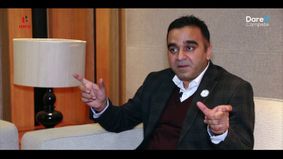
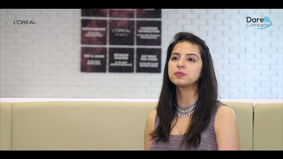
Comments
Add comment